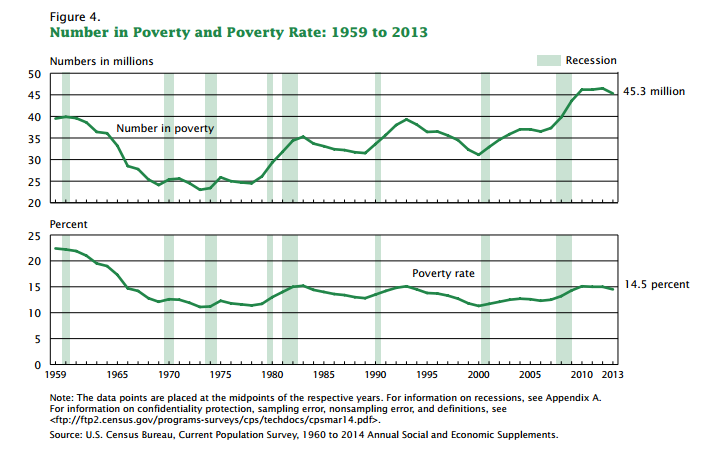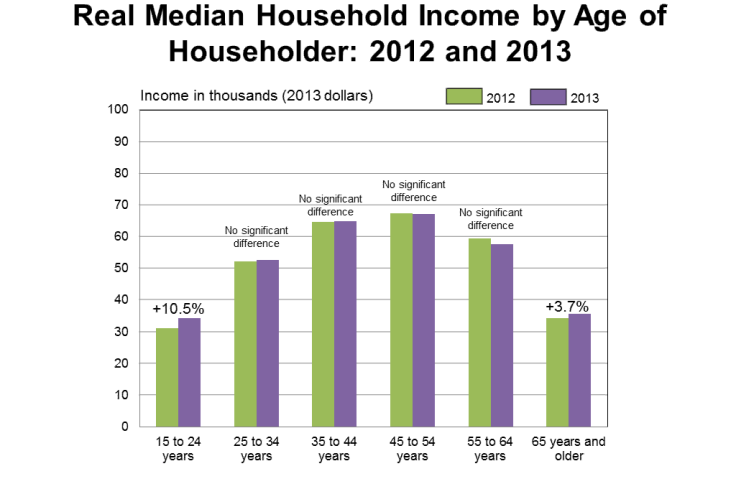American Poor And Middle Class Aren't Seeing Economic Recovery Yet — Census Bureau Report

Neither the number of Americans living in poverty nor the median U.S. household income has changed significantly since 2011, the Census Bureau said Tuesday. The bureau's report marks the latest evidence that the economic recovery has yet to reach most Americans.
Median household income in 2013 was about $51,900, 8 percent lower than in 2007, the year before the nation’s economy fell into recession, the annual report said. That’s about $4,100 less per family each year. Median income fell in 2009 and 2010 and hasn’t changed much since 2011, said Victoria Velkoff, the chief of social, economic and housing statistics at the Census Bureau.
The nation’s official poverty rate in 2013 was 14.5 percent, or 45.3 million people living at or below the poverty line, and after rising in 2010 it didn’t change significantly for the third consecutive year, she said. The poverty line in 2013 for a family of four was an annual income of about $23,800. In 2007, 12.5 percent of Americans lived in poverty, a difference of about 7 million people from 2013. But the poverty rate for children under 18 declined for the first time since 2000, from 21.8 percent in 2012 to 19.9 percent in 2013. Part of the decline may be due to a slowdown in immigration and fewer children living with single mothers compared to 2012.
"Many middle-class families were forced into a lower standard of living during the recession and during this anemic economic recovery," said Chris Christopher, director of consumer economics at IHS Global Insight. "There are many households that are living paycheck to paycheck."
The estimates are obtained through a supplement to a nationwide household survey, the Current Population Survey, used to estimate unemployment and other economic indicators.
The trend in this year's report continues a nearly half-century of economic stagnation for some groups. Fifty years ago, Lyndon Johnson famously declared a war on poverty. Poverty began falling significantly in the 1960s before the declaration, from 32 percent in 1950 to 17 percent by 1965, the first year after Johnson's plan. But in the past 40 years, the number of Americans living below the poverty line hasn't budged much from about 14 percent.

While income over the past 40 years hasn’t changed much for the bottom 60 percent of wage earners, the wealthiest 10 percent and 5 percent of Americans now earn about 30 percent more, the Census Bureau said, though the percentiles don’t necessarily capture movement between income groups over a person’s lifetime.

Asian-headed households earned a median $67,100 in 2013, compared with $58,300 in non-Hispanic white-headed households, $41,000 in Hispanic-headed households and $34,600 in black-headed households, the report said. Black Americans have increased their wealth by 30 percent over four decades, the most by any race, followed by non-Hispanic white Americans by 13 percent.
Most age groups didn’t see their incomes rise from 2012 to last year, but people aged 15 to 24 years of age added 10.5 percent to their wealth and those 65 years and older, 3.7 percent, the report said.

Gross domestic product increased in about 77 percent of metropolitan areas in the U.S. last year, at a pace of 1.7 percent overall compared to 2.6 percent in 2012, the Bureau of Economic Analysis said Tuesday.
Christopher expects 2014 to be a turning point for median household incomes "since employment gains have been relatively better and consumer price inflation has been modest," he said.
On Thursday, the Census Bureau will report poverty and income measures from 2013 for all states, counties and regions with at least 65,000 people.
© Copyright IBTimes 2024. All rights reserved.






















